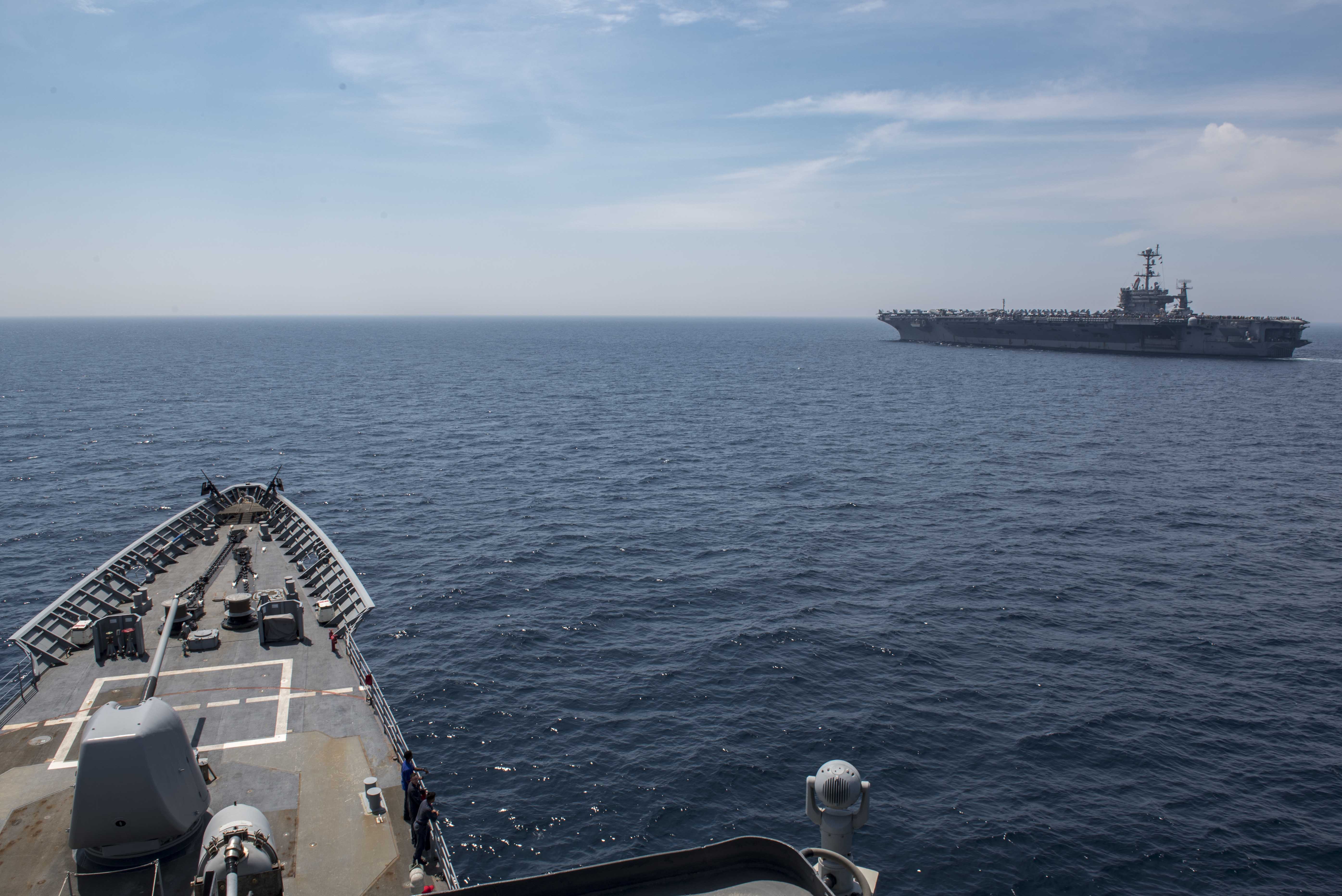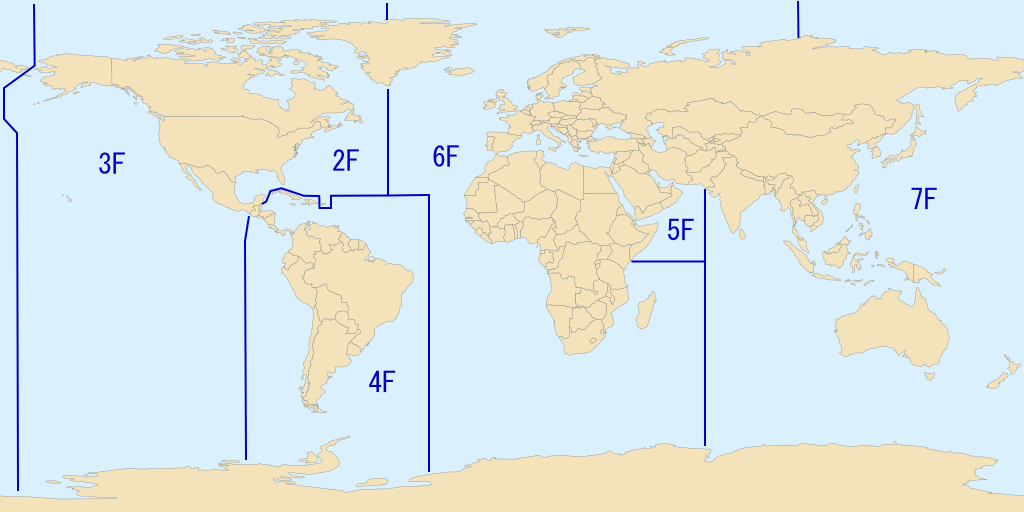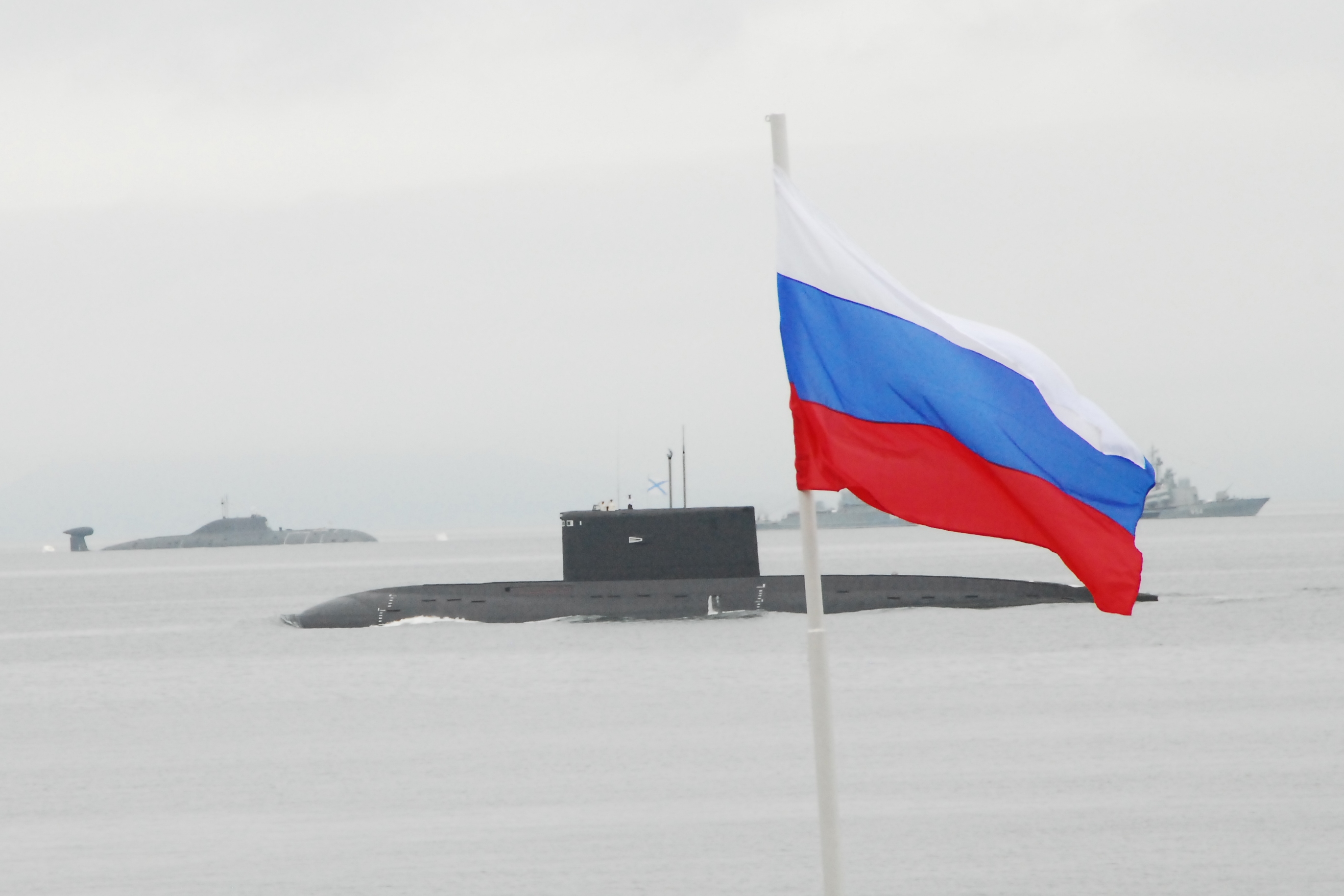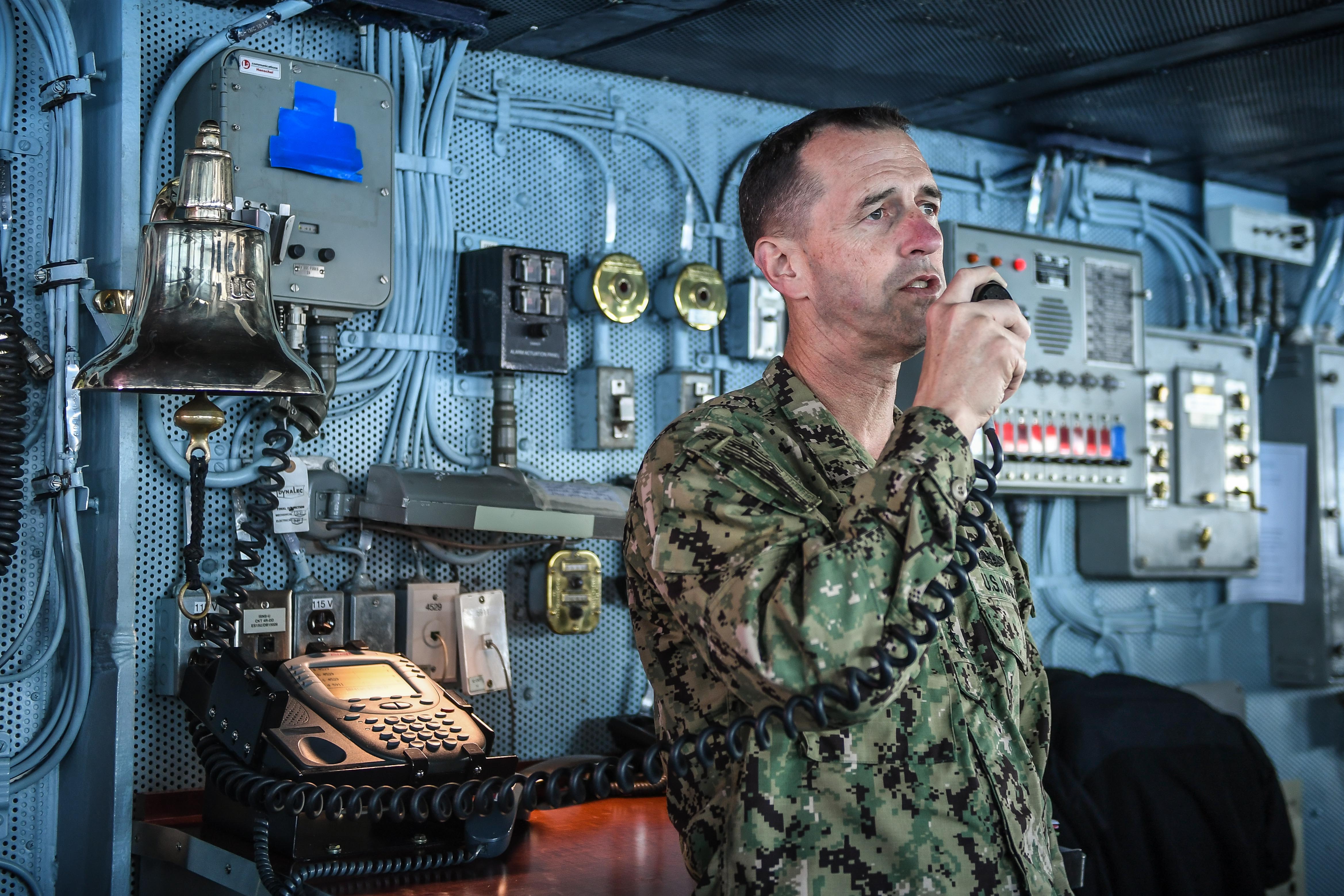
USS Normandy (CG-60) steams alongside the Nimitz-class aircraft carrier USS Harry S. Truman (CVN-75) on Jul 8, 2018. US Navy Photo
This post has been updated to include additional information from U.S. Fleet Forces Command.
USS Harry S. Truman (CVN-75) is operating in the North Atlantic over the old stomping grounds of the Soviet submarine force, in the latest twist of a deployment that has broken with almost 20 years of U.S. carrier tradition, USNI News has learned.
A mere three months after deploying from Naval Station Norfolk, Va., a portion of the carrier strike group is now operating in the area of operations of U.S. Fleet Forces Command – which will soon be the territory of the reestablished U.S. 2nd Fleet – closer to Canada than to Europe. The region is where the Atlantic Ocean is its most deep and used to be a Cold War stalking ground for U.S. attack boats on the hunt for Soviet submarines.
U.S. Fleet Forces Command did not directly answer USNI News questions regarding Truman‘s activities so far west in the Atlantic, but the command did issue a statement late Monday.
“The National Defense Strategy directs us to be operationally unpredictable while remaining strategically predictable. As such, select units from the USS Harry S. Truman (CVN 75) Carrier Strike Group (CSG) will return to Norfolk, Virginia, this week – a direct reflection of the dynamic force employment concept, and the inherent maneuverability and flexibility of the U.S. Navy,” commander of Fleet Forces Command Adm. Christopher Grady said in a statement.
“The Truman CSG has had an incredibly successful three months in the U.S. 6th Fleet area of responsibility. The ship accomplished every objective established for its crew, from striking ISIS in Syria to expanding partnerships and exercising with our friends and allies.”
The statement did not say whether the carrier would be returning to Virginia or just some of its escorts.
“As a matter of longstanding policy, we do not discuss future operations, but I can tell you that the Harry S. Truman Carrier Strike Group will continue to conduct operations in support of our NATO allies, European and African partner nations, coalition partners, and U.S. national security interests,” Cmdr. John Perkins, a spokesman with U.S. Naval Forces Europe and Africa, told USNI News in June when Truman left the Mediterranean for the Atlantic.
U.S. military leaders have repeatedly stressed the growing submarine threat from a resurgent Russia that has increased operations in the North Atlantic.

Navy map of the soon-to-be-reestablished U.S. 2nd Fleet, where Truman is operating. US Navy Photo
Truman deployed with a larger-than-average destroyer complement, and those ships have simultaneously operated from as far north as Norway to as far south as the Red Sea. The destroyers are equipped with a very capable anti-submarine warfare suite that isn’t often used in the Atlantic theater, Bryan Clark, a senior fellow at the Center for Strategic and Budgetary Assessments, told USNI News last month.
“Our Atlantic coast guys need a chance to train against good submariners. … Either they’re doing it with the French or the British for training or for hope of finding a Russian submarine,” he told USNI News.
“You have to make a special effort to put them there.”
The carrier itself has limited anti-submarine warfare capabilities resident in the carrier air wing’s helicopter squadrons, leaving the bulk of the ASW responsibility on strike group escorts.
Regardless of the specific mission, the unexpected move of the strike group into the Fleet Forces AOR is yet another example of how the Navy is breaking from years of precedent in carrier deployments since Trumanand its escorts left port in April.
Since the terror attacks of Sept. 11, 2001, the center of gravity of U.S. carrier movement has been the Persian Gulf, as strike fighters sortied to support the ongoing ground wars in Afghanistan and Iraq. At the height of both wars, air powers from U.S. carriers were responsible for up to a third of the missions over Afghanistan. In 2014, the strikes expanded to include targeting Islamic State militants in Syria, with some strikes coming from the Eastern Mediterranean as the U.S. Navy rubbed shoulders with Russian warships operating in the region.

A Russian Kilo submarine passes the parade stand during the Russia Navy Day celebration in Vladivostok. US Navy Photo
Now, the Gulf hasn’t seen a carrier since the USS Theodore Roosevelt (CVN-71) left in March, and the region was host to big-deck amphibious warship USS Iwo Jima (LHD-7) for only a couple of weeks during the LHD’s ongoing deployment.
The unexpected deployments are part of a new scheme the Navy is employing as a reaction to a more militarily ambitious Russia and China.
While not speaking about the Truman CSG specifically, Chief of Naval Operations Adm. John Richardson told USNI News in May that a “dynamic force employment” model would bring many benefits to the Navy.
“If you think about all the ways you could increase really the power of the Navy, it’s not necessarily going forward, disaggregating the strike group and doing those sorts of operations. Maybe we increase naval power by bringing the strike group back a little bit early; we do high-end strike-group-on-strike-group exercises or training like that,” he said.
Richardson said that the need to be more unpredictable is outlined in the National Defense Strategy that the Trump Administration released in January, but he said it’s also a return to how the Navy has conducted itself in the past.

Chief of Naval Operations Adm. John Richardson addresses the crew of the aircraft carrier USS Theodore Roosevelt (CVN-71) Dec. 30, 2017. US Navy Photo
“The Navy is sort of a naturally dynamic force. It’s the nation’s maneuver force, the Navy/Marine Corps team. And so we look to restore even more maneuver, restore that dynamism that has honestly become a little bit predictable,” he said.
“We kind of deploy on a very predictable schedule, we go to a predictable place, and we come back in a predictable time. So we’re going to try to stir that up a little bit so we’re not so easy to figure out.”
Richardson said he was optimistic about the benefits of adding in this operational unpredictability and creating new opportunities to practice high-end warfighting instead of conducting the usual disaggregated operations during a deployment. Few navies around the world can even aggregate multiple strike groups, he said, and he wants to flex the U.S. Navy’s ability to do CSG-on-CSG exercises, two-CSG operations, or even loop in a friendly navy such as France’s Charles de Gaulle carrier strike group once the aircraft carrier gets back to operating at sea later this year.
“I think it’s just an aspect of the security environment that it’s getting harder to do things without being observed, no matter where you are. And so we’re going to have to be clever about that,” he said, acknowledging concerns from last year’s three-CSG operations that the U.S. ships couldn’t do much more than simply aggregate because they were within clear view of China and wouldn’t want to give away any high-end capabilities.
The following is the complete statement from U.S. Fleet Forces Command commander Adm. Christopher Grady:
The National Defense Strategy directs us to be operationally unpredictable while remaining strategically predictable. As such, select units from the USS Harry S. Truman (CVN 75) Carrier Strike Group (CSG) will return to Norfolk, Virginia, this week – a direct reflection of the dynamic force employment concept, and the inherent maneuverability and flexibility of the U.S. Navy.
The Truman Carrier Strike Group has had an incredibly successful three months in the U.S. 6th Fleet area of responsibility. The ship accomplished every objective established for its crew, from striking ISIS in Syria to expanding partnerships and exercising with our friends and allies.
Let me be clear – all returning units are 100 percent mission capable and will remain in the sustainment phase of the Optimized Fleet Response Plan, which means they will sustain warfighting readiness and be ready to surge forward or redeploy when called upon.
As with any in-port period, routine maintenance will be conducted on ships, aircraft and equipment, and Sailors will take the opportunity to continue advanced training, maintain warfighting certifications, as well as spend time with their families.
